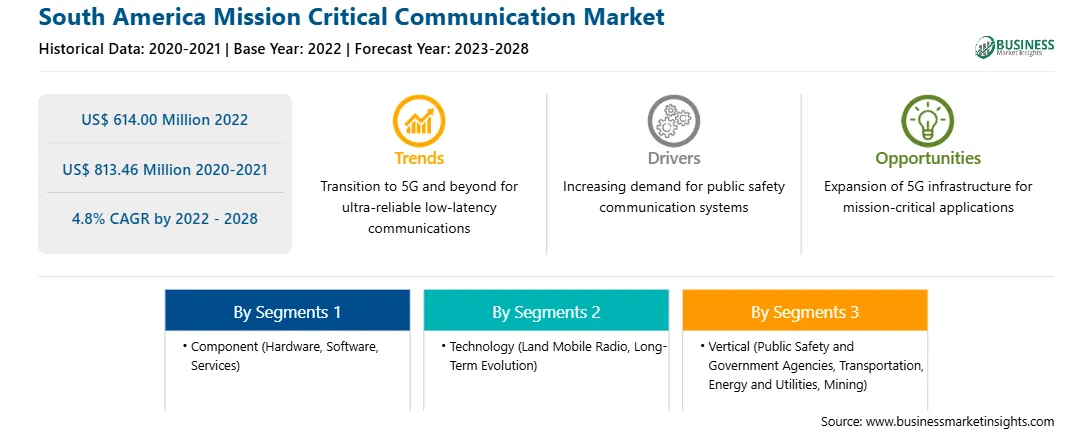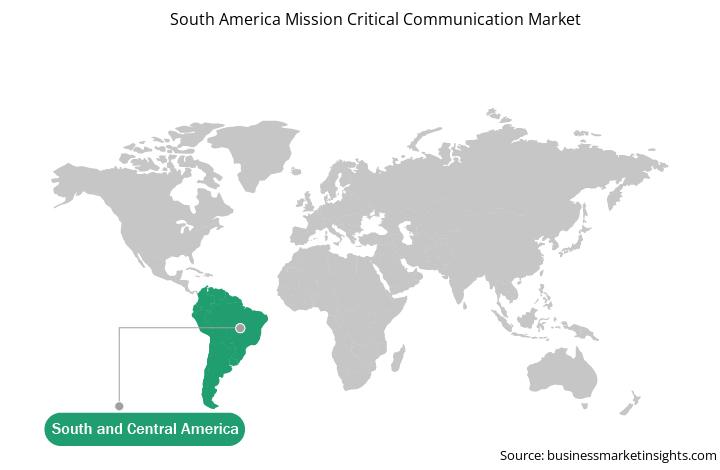The mission critical communication market in South America is expected to grow from US$ 614.00 million in 2022 to US$ 813.46 million by 2028; it is estimated to grow at a CAGR of 4.8% from 2022 to 2028.
Traditionally, mission critical communication systems were in use to communicate only general information and commands in public safety and government agencies, transportation infrastructure, and energy & utility sectors. With the integration of advanced technologies, including IoT, biometrics, and drone technology, the efficiency of mission critical communication systems has increased considerably. The modern MCX systems aid in advanced information communications with the help of video analytics and sensors. Countries in SAM are leveraging the changing perspective of mission critical communications. Moreover, high-capacity radio, 5G-supported radio, software-defined networking, automation, virtualization, network slicing, proximity communication, and positioning are capable of prioritizing communication and ensuring secure data transfer for boosting mission critical communications. Features such as video streaming, exchange of real-time information, solutions to evolve existing LMR networks to advanced LTE/5G networks, identifying threats with artificial intelligence, deploying cloud solutions for remote operations, public networks with mission-critical enhancement, development of LTE coupled with existing technology like Wi-Fi and new radio access technologies including 5G NR and narrowband Io are coming into picture which are projected to propel the scope of mission critical communication
Strategic insights for the South America Mission Critical Communication provides data-driven analysis of the industry landscape, including current trends, key players, and regional nuances. These insights offer actionable recommendations, enabling readers to differentiate themselves from competitors by identifying untapped segments or developing unique value propositions. Leveraging data analytics, these insights help industry players anticipate the market shifts, whether investors, manufacturers, or other stakeholders. A future-oriented perspective is essential, helping stakeholders anticipate market shifts and position themselves for long-term success in this dynamic region. Ultimately, effective strategic insights empower readers to make informed decisions that drive profitability and achieve their business objectives within the market. The geographic scope of the South America Mission Critical Communication refers to the specific areas in which a business operates and competes. Understanding local distinctions, such as diverse consumer preferences (e.g., demand for specific plug types or battery backup durations), varying economic conditions, and regulatory environments, is crucial for tailoring strategies to specific markets. Businesses can expand their reach by identifying underserved areas or adapting their offerings to meet local demands. A clear market focus allows for more effective resource allocation, targeted marketing campaigns, and better positioning against local competitors, ultimately driving growth in those targeted areas.South America Mission Critical Communication Strategic Insights

South America Mission Critical Communication Report Scope
Report Attribute
Details
Market size in 2022
US$ 614.00 Million
Market Size by 2028
US$ 813.46 Million
CAGR (2022 - 2028) 4.8%
Historical Data
2020-2021
Forecast period
2023-2028
Segments Covered
By Component
By Technology
By Vertical
Regions and Countries Covered
South and Central America
Market leaders and key company profiles
South America Mission Critical Communication Regional Insights

South America Mission Critical Communication Market Segmentation
The South America mission critical communication market is segmented on the basis of component, technology, vertical, and country. Based on component, the market is segmented into hardware, software, and services. In 2022, the hardware segment is estimated to dominate the market. The market for mission critical communication hardware is further segmented into command and control centers, routers and gateways, and distribution management systems. In 2022, the distribution management system segment is expected to dominate the market for hardware. Based on technology, the South America mission critical communication market is categorized into land mobile radio (LMR) and long-term evolution. In 2022, the long-term evolution segment is likely to lead the market. Based on vertical, the South America mission critical communication market is segmented into public safety and government agencies, transportation, energy and utilities, mining, and others. In 2022, the public safety and government agencies segment is expected to dominate the market. The South America mission critical communication market, based on country, is segmented into Brazil, Argentina, and the rest of South America. In 2022, Brazil dominated the market.
Key players dominating the South America mission critical communication market are Huawei Technologies Co. Ltd.; Hytera Communication Corporation Limited; Motorola Solutions, Inc.; Nokia Corporation; Tassta GmbH; and Telefonaktiebolaget LM Ericsson.
The South America Mission Critical Communication Market is valued at US$ 614.00 Million in 2022, it is projected to reach US$ 813.46 Million by 2028.
As per our report South America Mission Critical Communication Market, the market size is valued at US$ 614.00 Million in 2022, projecting it to reach US$ 813.46 Million by 2028. This translates to a CAGR of approximately 4.8% during the forecast period.
The South America Mission Critical Communication Market report typically cover these key segments-
The historic period, base year, and forecast period can vary slightly depending on the specific market research report. However, for the South America Mission Critical Communication Market report:
The South America Mission Critical Communication Market is populated by several key players, each contributing to its growth and innovation. Some of the major players include:
The South America Mission Critical Communication Market report is valuable for diverse stakeholders, including:
Essentially, anyone involved in or considering involvement in the South America Mission Critical Communication Market value chain can benefit from the information contained in a comprehensive market report.